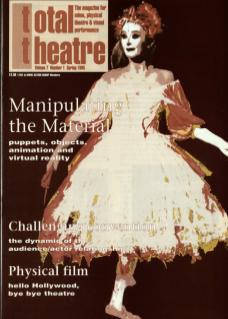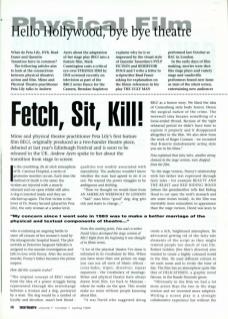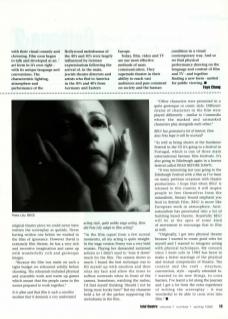In the crumbling, fin de siècle atmosphere of St. Caninus Hospital, a series of gruesome murders occurs. Each time the method of death is the same: the victims are injected with a muscle relaxant and cut open whilst still alive, a dog is inserted inside, and they are stitched up again. The first victim is the lover of Dr. Penny Second (played by Peta Lily), the only woman at a senior level who is enduring an ongoing battle to stave off closure of her women's ward by the misogynistic hospital board. The plot unfolds as Detective Sergeant Stiltskin is assigned to the murder investigation and falls in love with Penny. After the second murder, Penny's father becomes the prime suspect.
How did this scenario evolve?
‘The original concept of Beg! started from the idea of a power struggle being represented through the interchange between a woman and a dog, portrayed by a man. The dog would be a symbol of loyalty and devotion – man's best friend – qualities not readily associated with masculinity. The audience wouldn't know whether the man had agreed to do it or not. We wanted the power struggles to be ambiguous and shifting.
Then we thought we would draw from An American Werewolf in London – ‘bad’ man bites ‘good’ dog, dog gets sick and starts to change...’
From this starting point, Peta and co-writer David Glass developed the stage version of Beg! Right from the beginning it was thought of in filmic terms.
‘A lot of the physical theatre I've done is informed in its vocabulary by film. When you have more than one person on stage you can use all sorts of filmic effects: cross-fades, wipes, dissolves, repeat sequences – the vocabulary of montage. Mime and physical theatre have always drawn from film. Go back to Marceau – where he walks on the spot. This would make no sense without people knowing about film.
It was David who suggested doing Beg! as a horror story. We liked the idea of Cronenberg style body horror. Hence the surgical nature of the crime. The werewolf idea became something of a loose-ended thread. Because of the tight rehearsal period we didn't have time to explore it properly and it disappeared altogether in the film. We also drew from the work of Roger Corman – we recreated that B-movie melodramatic acting style you see in his films.’
Peta explained that fairy tales, another strong element in the stage version, were dropped from the film.
‘In the stage version, Penny's relationship with her father was expressed through fairy tales - for example Beauty and the Beast and Red Riding Hood [where the grandmother tells Red Riding Hood to cut open the wolf's stomach and sew some stones inside]. As the film was inevitably more naturalistic in appearance than the stage version, David was keen to create a rich, heightened atmosphere. He advocated getting rid of the fairy tale elements of the script as they might remind people too much of real life. Robert Golden [the film's director] also wanted to create a highly coloured world in the film. He used different colours to set each room and to evoke the time of day. The film has an atmosphere quite like that of Delicatessen, a graphic novel flavour, in the Bande Dessinée genre.
Obviously in the film we had a lot more actors than the two in the stage version and we invented more subplots. Writing a screen play is a strongly collaborative experience but without the original theatre piece we could never have written the screenplay as quickly. Never having written one before we worked in the bliss of ignorance. However, David is extremely film literate, he has a very rich and inventive imagination and came up with wonderfully rich and grotesque images.
Because the film was made on such a tight budget we rehearsed solidly before shooting. The rehearsals included physical and ensemble work and warm up games which meant that the people came to the scenes prepared to work together.’
It is often said that film is such a sensitive medium that it demands a very understated acting style, quite unlike stage acting. How did Peta Lily adapt to film acting?
‘In the film (apart from a few surreal moments), all my acting is quite straight. In the stage version Penny was a very held woman. Playing her demanded sustained actions so I didn't need to 'tone it down' much for the film. The camera shows so much. I found the best technique was to fill myself up with emotion and then relax my face and allow the inner to suffuse outwards when in front of the camera. Sometimes, watching the rushes, I'd find myself thinking “Should I not be being more kooky here?”. But my character held a lot of the pathos supporting the melodrama in the film.
Other characters were presented in a quite grotesque or comic style. Different strata of characters in the film were played differently – similar to Commedia where the masked and unmasked characters play alongside each other.’
Beg! has generated a lot of interest. How does Peta hope it will be received?
‘As well as being shown at the Sundance Festival in the US it's going to a festival in Portugal, which is one of three main international fantasy film festivals. It's also going to Edinburgh again in a horror festival called Dead Before Dawn.
It was interesting last year going to the Edinburgh Festival with a film, as I've been on many previous occasions with theatre productions. I hope that when Beg! is released in this country it will inspire people to free themselves from the naturalistic, literary bound emphasis you find in British Film. Beg! is more like European work in atmosphere. Anti-naturalism has penetrated into a lot of building-based theatre. Hopefully Beg! will be at the apex of some kind of movement to encourage that in film as well.
Originally, I got into physical theatre because I wanted to create good roles for myself and I wanted to integrate acting with physical techniques. My concern since I went solo in 1983 has been to make a better marriage of the physical and textual components of theatre. The content and the craft – structure, convention, style – equally attended to. I wanted to do new things, to cross barriers. I've learnt a lot along the journey and I got a lot from the extra experience of writing the screenplay – it was wonderful to be able to cross over into film.’


